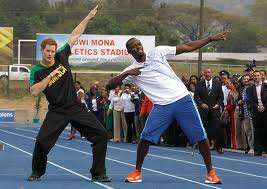With the 2012 London Olympics set to go, many are wondering just how fast Usain Bolt and the sprinters will be able to go in the 100 metres. That showcase event is easily the most watched at the Games. It wasn’t that long ago that people asked whether humans could break the 10 second barrier (unaided by performance enhancing drugs)
At the BBC’s Future webpage, Ed Yong is asking whether it’s possible to predict whether the 9 second barrier will ever be broken:
That’s a surprisingly difficult question to answer, and ploughing through the record books is of little help. “People have played with the statistical data so much and made so many predictions. I don’t think people who work on mechanics take them very seriously,” says John Hutchinson, who studies how animals move at the Royal Veterinary College in London, UK.
The problem is that the progression of sprinting records is characterised by tortoise-like lulls and hare-like… well… sprints. People are getting faster, but in an unpredictable way. From 1991 to 2007, eight athletes chipped 0.16 seconds off the record. Bolt did the same in just over one year. Before 2008, mathematician Reza Noubary calculated that “the ultimate time for [the] 100 meter dash is 9.44 seconds.” Following Bolt’s Beijing performance, he told Wired that the prediction “would probably go down a little bit”.
John Barrow from the University of Cambridge – another mathematician – has identified three ways in which Bolt could improve his speed: being quicker off the mark; running with a stronger tailwind; and running at higher altitudes where thinner air would exert less drag upon him. These tricks may work, but they’re also somewhat unsatisfying. We really want to know whether flexing muscles and bending joints could send a sprinter over the finish line in 9 seconds, without relying on environmental providence.
To answer that, we have to look at the physics of a sprinting leg. And that means running headfirst into a wall of ignorance. “It’s tougher to get a handle on sprinting mechanics than on feats of strength or endurance,” says Peter Weyand from Southern Methodist University, who has been studying the science of running for decades. By comparison, Weyand says that we can tweak a cyclist’s weight, position and aerodynamic shape, and predict how that will affect their performance in the Tour de France. “We know down to 1%, or maybe even smaller, what sort of performance bumps you’ll get,” he says. “In sprinting, it’s a black hole. You don’t have those sorts of predictive relationships.”
Yong concludes that people placing ceilings on human performance are ill-informed. For now, I’m waiting for someone to break the 9.5 barrier.


